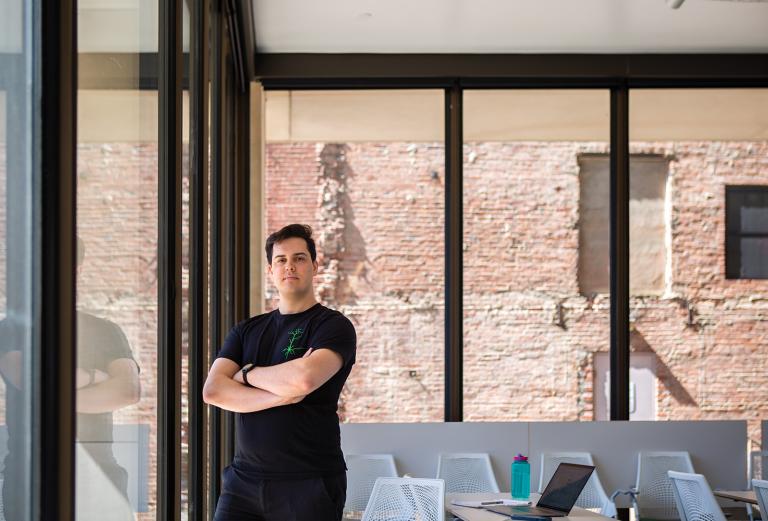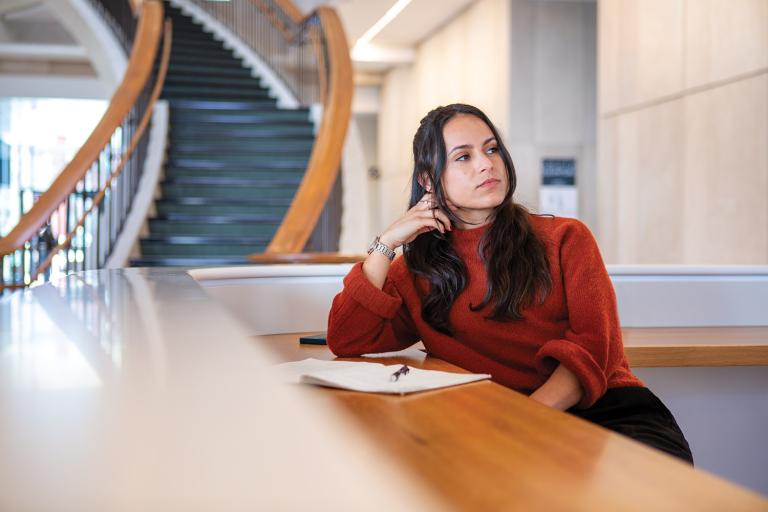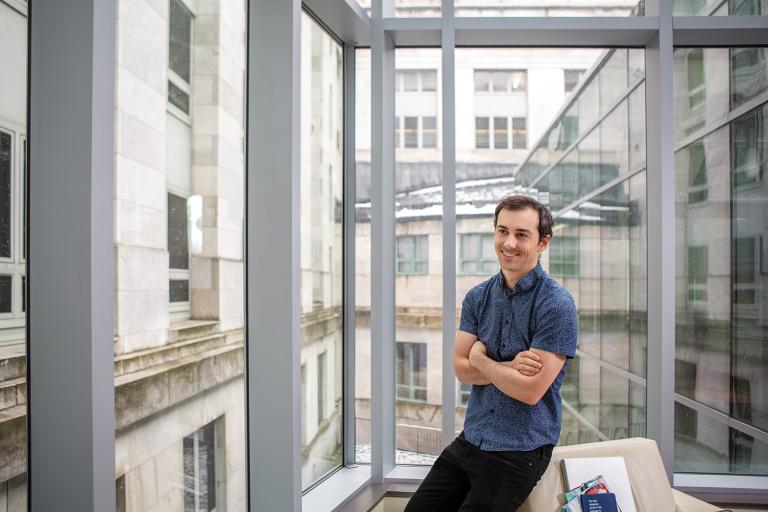Hooked on Neuroscience
Three PhD candidates — Winthrop Gillis, Alyssa Larios, and Richard Hakim — discuss what drew them to the discipline
- 7 minute read
- Profile

Winthrop Gillis
What “changed everything” for neuroscience PhD candidate Winthrop Gillis was taking his first biology class as a high school sophomore. “I had been interested in science — robots and space and atoms — from the youngest age I can remember,” he says. “But when I learned that DNA controls how we look, how we behave, and how we develop by encoding proteins, I was hooked.”
He looked for a college with a protein-engineering department but was ahead of his time. “The field hadn’t developed enough to have an entire department dedicated to it,” he says, so he attended Boston University, majoring in behavioral biology. And again, one class — this time in psychology — was all it took to “steer my interest from proteins to the brain.”
He joined a lab that studied how zebra finches generate specific and consistent songs, or, more broadly, “how the brain stably generates stereotyped behaviors,” he says. Because there was also an engineering element to this work, he learned how to program a type of open-source software that runs microcontrollers used in experiments. This skill allowed him some creativity in designing experiments and helped him get a job in that same lab after graduation.
Harvard neurobiology professor Sandeep Robert Datta, MD ’04 PhD ’04, stopped by the lab Gillis was working in one day to talk with the lab about his research exploring animal behavior by breaking it down into discrete modules similar to the “syllables” in a zebra finch’s song. Gillis took the opportunity to make a connection, and Datta later encouraged him to apply to the Harvard PhD Program in Neuroscience. He also invited Gillis to join his lab.
“We’ve found that dopamine is released all the time in the brain, even during spontaneous behavior,” Gillis says. “We believe that the dopamine released during spontaneous behavior is important for making sure animals can live effectively in dynamic environments where they have to modify their behavior. I’m hoping our work will lead to a better understanding of how the brain generates behavior in more naturalistic settings.”
Once Gillis completes his graduate work, he plans to switch gears, leaving academia for industry and using what he’s learned, along with his expertise in engineering and managing large data sets, to solve problems related to climate change. “It’ll be a 180,” he says, “but I think the skills I’ve learned will be valuable wherever I go.” There’s a part of him, he says, that would like to establish a start-up, perhaps one focused on genetically engineering algae to remove carbon at a faster rate. “Climate change feels like an unsolvable problem,” he says, “but with more time and more people thinking about it, maybe this insurmountable hill will look like something we can climb. I’m hoping working on it will scratch my itch to see what I can do to help to change the world.”

Alyssa Larios
When she was about eight years old, a special issue of National Geographic caught Alyssa Larios’s eye at the grocery store. Its cover promised a user’s guide to learning 100 things about the brain.
“My parents had zero influence on my choice of science,” she says, “except that they were keen to find opportunities to facilitate my interests.” Her mom bought the publication, and Larios spent hours poring over it. “I just really liked learning,” she recalls. “Once I got to middle school, what grabbed me most was cell biology. I thought it was elegant the way these tiny ecosystems fit together and that the molecular machinery that keeps it all clean and functioning and fed was happening at these microscales. I thought it was all so beautiful.”
At around age sixteen Larios sustained a minor chemical burn, and her mother’s friend, a nurse, made an unofficial house call to treat her. Through that nurse, Larios began volunteering in a burn clinic, where she became fascinated by how tissue repairs itself. “It was there I realized I wanted to do research,” she says. “Of course, at the time I didn’t know what failure feels like in a lab. But even failed experiments are informative.”
She started in the Harvard PhD Program in Neuroscience right after graduating from Northwestern University with a degree in the field. She had applied to several schools but when she came to Cambridge for her interview, she says, “I was struck by the sense of community in the neuroscience program. I got a great feeling from the other students. They seemed happy.”
The other reason she chose Harvard was that every conversation she had with a professor that weekend “left me feeling inspired by science and the possibilities for discoveries I could make here,” she says. “They were all just so excited to talk about their work and that was infectious.”
Now in her fourth year, Larios thinks the program has been a good fit for her, in large part because “the science being done here is so impactful.” She works in the lab of HMS neuroscientist Chenghua Gu, where she is studying how changes in blood flow to the brain affect neurons. “It seems intuitive that lowered blood flow might exacerbate disease,” she says, “but right now we only know there’s a correlation. If we could learn more, we might be able to start treating the root causes of neurodegenerative diseases rather than just the symptoms.”
Though Larios is “in the exploratory phase career-wise,” she thinks it would be “cool to work in science strategy, considering how to allocate resources, people, and time within a therapeutic program.” While she concedes that her work is just a small fraction of the research being done in her field, “science builds on itself,” she says. “Eventually progress is made on a grander scale.”

Richard Hakim
Growing up in a suburb of Los Angeles, Richard Hakim could be found around town with a video camera in hand. In high school, he won awards for editing and production and, after graduating, he got a job at an indie film studio. But when the movie industry was hit hard by the 2008 recession, he had a chance to step back and question whether Hollywood was really the place for him. He started reading more, taking long walks with his dog, journaling, and just “absorbing information.”
He took a few classes at a community college, but nothing really grabbed his attention until he took an introductory course in biopsychology. “I was blown away by how the retina and cochlea worked. I realized I had to transfer to a university doing neuroscience research, so I dedicated myself to getting perfect grades and really understanding everything.”
He went to the University of California, Berkeley, where he found the opportunities and challenges he was hoping for. “The classes were hard, the research was serious, and the people were weird in a good way.”
At Berkeley, Hakim worked in a lab studying how and why brain activity oscillates and generates what are known as brain waves. His work led to a few publications and eventually brought him to the Harvard PhD Program in Neuroscience. He anticipates his graduate school career will soon be completed.
At Harvard, Hakim works in the lab of HMS neuroscientist Bernardo Sabatini, MD ’99 PhD ’99. where he builds brain-machine interfaces in rodents with the aim of studying how to optimally infer “intention” from neural recordings. He’s not sure what his future holds but knows he wants to “be free to explore my own curiosities.”
What he is sure of is that the work he’s doing has important implications for people with motor impairments, and for the world in general.
“Animals have been useful in building the groundwork,” he says, “but once we start getting large amounts of human data, the things we’ll be able to find will be incredible. I see a world where people are able to relate to each other more intimately, where we can empathize with each other’s peculiarities a lot better. I hope it will lead to a more harmonious society.”
Elizabeth Gehrman is a Boston-based writer.
Images: John Soares